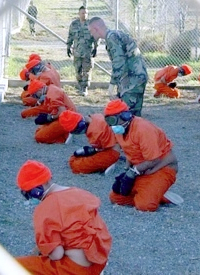
Recently released classified military documents regarding the treatment of prisoners at Guantanamo Bay have once again forced the Obama administration to defend the continued presence of the military detainment camp in Cuba, where 172 men remain.
According to The Blaze, “The files-known as Detainee Assessment Briefs or DABs — describe the intelligence value of the detainees and whether they would be a threat to the U.S. if released.” The files were released on Sunday evening after being obtained by Wikileaks and released to U.S. and European newspapers.
MSNBC reports on the background and information found in the DABs, which will likely help to affirm activists’ claims about the human rights violations said to take place at Gitmo:
Military intelligence officials, in assessments of detainees written between February 2002 and January 2009, evaluated their histories and provided glimpses of the tensions between captors and captives. What began as a jury-rigged experiment after the 2001 terrorist attacks now seems like an enduring American institution, and the leaked files show why, by laying bare the patchwork and contradictory evidence that in many cases would never have stood up in criminal court or a military tribunal.
The documents provide the meticulous details pertaining to each detainee, including the items found on their persons upon their capture, the physical ailments of the prisoners, any confrontations that have taken place between the prisoners and guards, and the specifics of each interrogation they have undergone.
The documents raise questions about the methodology at Gitmo, as they reveal that nearly 200 of the 600 prisoners transferred to other countries or freed had been classified as “high risk” while most of the 172 remaining prisoners have also been rated “high risk.”
The classified documents also reveal harsh interrogation tactics, which includes sleep deprivation, shackling in stress positions, and exposure to cold temperatures, tactics which have already drawn international condemnation.
Business Insider writes:
You can read instances of unwarranted detention, the interrogation of a senile 89-year-old and a 15-year-old and waterboarding. Prisoners are accused of hurling urine and feces at guards. Guards are accused of flushing Korans down the toilet and other forms of psychological torture.
The files also reveal how dangerous the detainees are, as many vow to wage war against America if released. 42 detainees who were released did return to battle.
The documents handle sensitive information about high-profile suspects, including Khalid Sheikh Mohammed, the suspected mastermind of the September 11th attacks, and Abd al-Rahim al-Nashiri, a participant in the 2000 bombing of the U.S. Cole.
The Washington Post reports that the DABs also reveal pertinent information on the whereabouts of Osama bin Laden and his top deputy Ayman al-Zawahiri following the September 11th attacks.
Additionally, the documents are said to contain rare pictures of some of the inmates.
MSNBC outlines the findings of the documents here, which include the role of foreign officials in interrogations.
Remarking on the leaked documents is Ambassador Daniel Fried, the Obama administration’s special envoy on detainee issues, who said, “It is unfortunate that several news organizations have made the decision to publish numerous documents obtained illegally by Wikileaks concerning the Guantanamo detention facility.”
Other U.S. officials indicate that the information found in the documents “may or may not represent the current view of a given detainee” and therefore criticized the decision to publish such “sensitive information.”





